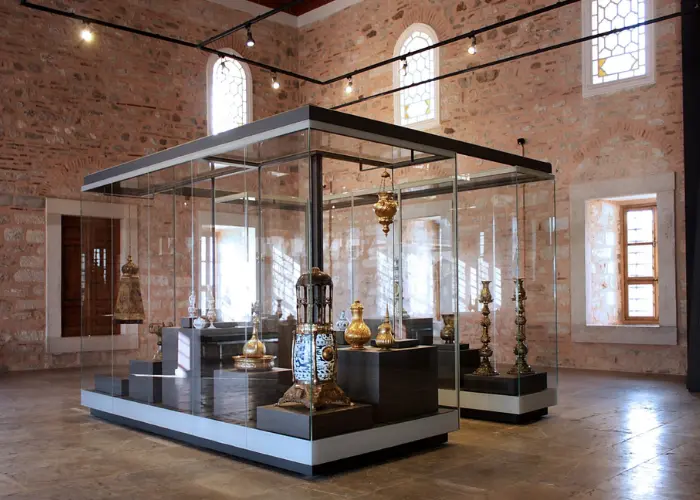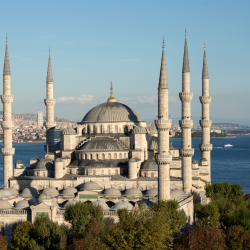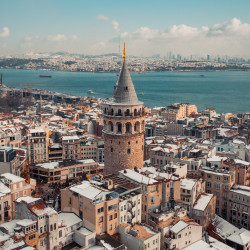The museum was first opened in the Süleymaniye Mosque Complex in 1914 as the “Evkaf-ı İslâmiye Müzesi” (The Islamic Foundations Museum). During the Republican period, the name of the museum was changed to the “Museum of Turkish and Islamic Arts”. It was moved to the Ibrahim Paşa Palace in Sultanahmet in 1983.
Originally, Sultan Süleyman the Lawgiver offered this palace, which dates from the 16th Century, as a gift to the Grand Vizier Ibrahim Pasha. After Ibrahim Pasha’s death, it continued to be used as a place of residence for grand viziers, ambassadors, and other high officials.
In spite of the fact that most civil and government buildings during the Ottoman period were made of wood, the Ibrahim Paşa Palace was built with stone, and, therefore, has remained in excellent condition up to the present day. Today, the building’s “ceremony room” and “second court” are used to house the museum’s collection.
Handwritten Qurans, Epigraphs, Hand-woven Carpets, and Rugs
The museum, which houses the richest collection of carpets in the world, has a large number of particularly striking carpets from the Seljuk Empire¸ the most important Turkish state prior to the Ottoman Empire. Rugs that were produced in Anatolia during the 15th, 16th, and 17th centuries, are typically ornamented with geometric figures, Kufic designs, and animals, and are among the most valuable items in this section. Here, you also find exquisite rugs from Iran and the Caucasus.
Hand-written Qurans and hand-written decrees, acquittals, and monograms from Ottoman Sultans are also to be found in the museum’s collection.
In the museum’s “Wooden Artifacts Section”, you can examine artifacts that date from Anatolia in the 9th and 10th centuries, as well as wooden artwork embellished with mother-of-pearl and ivory from Ottoman times.
There are also many stone artifacts on display in the museum. Some of the most fascinating stone items are the tombstones from the Seljuk era, which represent a branch of calligraphy quite different from the Ottoman version. Hunting scenes and mythological creatures such as gryphons and dragons are often featured on these tombstones.
One of the most important proofs of the Islamic culture that was dominant in the city during the Ottoman Empire is the Turkish Islamic Art Museum.
The Turkish Islamic and Art Museum has a lot of items that explain how the culture that used to be dominant resulted in a developed philosophy and technologies.
The Turkish Islamic and Art museum was constructed in the early 1500s and was called at that time the palace of Ibrahim Pasha which is a residential palace that was built by Sultan Suleyman’s friend Ibrahim Pasha. The sultan was actually influenced a lot by his friend Ibrahim pasha in a way that concerned the sultan’s wife and she was mad when Ibrahim pasha supported the candidate Mustafa to take over the throne over her son and resulting in accusing Ibrahim pasha to be a traitor, later in 1536 Ibrahim pasha’s wealth was seized by the government.
Back to the Turkish Islamic and art museum, the museum was founded in the 19th century and was the first museum that has old Islamic items and was located in the former alms-house in the Suleymaniye Mosque Complex but after the establishment of the Turkish Republic it was moved to its current place in the restored palace of Ibrahim pasha in Sultanahmet Area
The Turkish Islamic art museum has many beautiful and important items that go back to the Ottoman Empire period and Seljuk Empire’s period, and even older empires.
The impressive collection of items includes Islamic items such as old Qurans, old documents from Damascus, the Kaaba Tile, and Islamic art paintings that show fine examples of calligraphy Islamic art and how detailed it is.
When you enter the museum make sure to see the handmade Anatolian carpets which were one of what is special about Anatolians in old times and considered the finest carpets in the world.
The Seljuk era shows an advanced and high level of skills and professionalism, you can actually see this in the details of wall tiles and wood carvings which somehow influenced the Ottoman style. Well, it is not a surprise because art during the Seljuk period was an important thing.
Do not forget to see the old war items and art items that go back to the Ottoman empire, it is absolutely worth spending time in front of it. If you get tired of walking around the treasury items, you can go out to the yard of the museum and drink a cup of tea there, maybe take some pictures too because it is very beautiful.

How to Get There?
You can use the T1 train line toward Eminonu and get off it at Sultanahmet station, the museum is very near to the famous Blue Mosque, and Basilica Cistern you will find it easily do not worry.
While if you are coming from the Asian side you can use the Ferries to cross the Bosphorus to Eminonu and then walk for 10-15 minutes to the museum or simply use the T1 train line from Eminonu toward Sultanahmet station
How much does it cost to enter the Turkish Islamic and Art Museum?
It is not expensive actually, but compared to other museums it is a little bit higher. You can go to the museum and buy your ticket but we suggest you get there with a guide. Here you can find our amazing Guided Turkish Islamic and Art Museum Tour.
How to Get There?
The Turkish Islamic and art museum opens its doors to guests every day except Mondays
From 15 April to 30 October, the museum welcomes guests between 9 am to 7 pm
While from 31 October to 14 April it welcomes guests between 9 am to 5 pm
The museum is closed on the day before and the first day of religious holidays like Ramazan and sacrifice feast, in addition to 31st December, and 1st of January which are Turkey’s public holidays
It is also important to know that the ticket counters close 30 minutes before the museum actually closes.
From the earliest time of Islamic art until the twentieth century, the museum includes a significant collection of works from the Umayyad, Abbasid, North African, Andalusian, Fatimid, Seljuk, Ayyubid, lhanlı, Mamluk, Timurid, Safavi states, and numerous Caucasian republics, principalities, and Ottoman periods. You can see all the beautiful works of art with a certificated guided tour with your Istanbul Tourist Pass.
The "Evkâfı-Islamiye" (Islamic Foundations Museum), later renamed the Museum of Turkish and Islamic Arts, opened for the first time in 1914 in the Süleymaniye Imaret Building, following the proclamation of the Republic. The museum was eventually relocated to the Ibrahim Pasha Palace, constructed at the end of the 15th century. Later, it was given to Ibrahim Pasha to be renovated and served as the grand vizier's palace during Suleiman the Magnificent's reign.
Since 1983, the Turkish and Islamic Arts Museum has been housed in Ibrahim Pasha Palace, located to the west of Sultan Ahmet Square. It is the only private palace that has survived to the present day, aside from Sultan's palaces.
There is also the importance of the Turkish and Islamic Arts Museum for the world besides its exhibitions. Having undergone restoration in 2012, the museum received the Council of Europe Museum of the Year Competition Special Jury Prize in 1984. In 1985, the museum was given the Council of Europe-UNESCO's award for endearing cultural heritage to children.
Inside and Outside the Turkish and Islamic Arts Museum
The Turkish and Islamic Arts Museum's first floor is approached through stairs from the terrace. In the rooms and hallways, rare works of art developed in many Islamic nations are on display. The museum is a remarkable tourist attraction since it entails walking around on a mysterious voyage connecting religion and art through time.
Artifacts were recovered during excavations at the two cities in Syria, Raqqa and Samarra, both key early Islamic towns. The Damascus Documents Department contains the works that came from the Umayyad Mosque in Damascus. The Department of Sacred Relics houses the Prophet's Footprint, known as Kadem-i Saadet, and the beard strands, known as Sakal-ı Şerif. The most valuable carpets, ceramics, metal, wood, glass, stone, and manuscripts belonging to the Anatolian Seljuk and Ottoman periods are exhibited in the Divanhâne Department.
A fascinating building combines architectural beauty, historical richness, and peace of faith! Through the glass roof in the courtyard or the Hippodrome Ruins Hall on the ground floor, you can see the ruins of the Constantinople Hippodrome. You should also see the Blue Mosque while speaking of the most precious artworks from Turkey’s religious history! In addition, there is a plane tree in the museum's courtyard that is roughly 200 years old and draws tourists with its turban-shaped body.

Turkish and Islamic Arts Museum Facts
-
The Museum of Turkish and Islamic Art is the first Turkish museum to cover Turkish and Islamic Artworks collectively.
-
Turkish and Islamic Arts Museum is also the last museum opened in the Ottoman Period.
-
Only the 'Manuscripts' section of the museum hosts 18 thousand 298 works.
-
The collection, where masterpieces of handcrafted Turkish carpets, numbering up to 1,700, are exhibited in the large glazed section of the large halls, is one of the richest collections in the world.
-
On the lower floor of the carpet section, there is the "Ethnography Section." Turkish daily life and works of the last few centuries are exhibited in it.
Frequently Asked Question
Why Should I Visit the Turkish and Islamic Arts Museum?
For local tourists, to get to know more deeply about their roots of art, religion, and history is needed. If you are coming from abroad, with the Istanbul Tourist Pass, you can enjoy getting informed about the past of your world neighbors. The quality guided tours will help while you observe the magnificence of the unique pieces of Islamic art.
How Much are the Tickets to Get into the Turkish and Islamic Arts Museum?
You can check the latest fee information at the Museum but don't forget to check Istanbul.com Guided Tours before you decide.
Should I Wait in Line for the Guided Tours of the Turkish and Islamic Arts Museum?
Skip-the-lines may be one of the best features of the Istanbul.com guided tours! Even for the most remarkable, famous, and crowded tourist attractions, you can enjoy the comfort of the forefront.
The Turkish and Islamic Arts Museum Opening Hours
You can visit the Turkish and Islamic Arts Museum is every day of the week. The museum's opening hours are between 09:00 and 20:00.
Should I Make a Reservation to Join the Guided Tour for the Turkish and Islamic Arts Museum?
No reservation is required for the guided tour. Just don’t forget that you cannot enter the museum with your digital Pass only. You should enter the museum with your guide.
 English
English  Indonesian
Indonesian  Urdu
Urdu  Taiwanese
Taiwanese  Russian
Russian  Romanian
Romanian  Portuguese
Portuguese  Persian
Persian  Macedonian
Macedonian  Korean
Korean  Japanese
Japanese  Italian
Italian  Indian
Indian  Hungarian
Hungarian  Greek
Greek  German
German  Croatian
Croatian  Chinese
Chinese  Bulgarian
Bulgarian  Arabic
Arabic  French
French  Spanish
Spanish 





